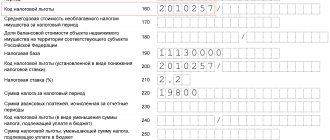Kontur.Accounting - 14 days free!
Friendly, simple and functional online service for small businesses.
Clear for the director, convenient for the accountant! Try it
In recent years, some innovations have appeared in the rules for paying property taxes. The form of the declaration has changed, the procedure for calculating tax based on cadastral value has been adjusted, and new grounds have emerged on which it can be changed. We will cover tax rates, exemptions, reporting and penalties for property taxes in 2020 and 2021.
How property tax will change in 2021
In 2021, several laws were adopted that affected the procedure for property taxation. Among the changes are the following:
- We have updated the property tax declaration form - the new form must be used for reporting for 2021 (Order of the Federal Tax Service of Russia dated July 28, 2020 No. ED-7-21 / [email protected] ). The new form takes into account coronavirus benefits, and also adds special arrangements for organizations that have entered into an agreement to protect and encourage investment.
- New codes for federal and regional benefits related to coronavirus have appeared.
- It no longer matters whether real estate is accounted for as a fixed asset; tax will still have to be paid unless the region decides otherwise.
- The list of real estate that is taxed at cadastral value has been increased. Now these are all objects that are subject to personal property tax. Residential premises, garages, parking spaces, unfinished construction projects, residential buildings, garden houses, utility buildings or structures on plots for personal households or individual housing construction were added to the old objects.
- Accountants no longer need to submit advance tax calculations; they have been canceled as of January 1, 2021.
- The tax return can be submitted centrally. If a taxpayer is registered simultaneously with several tax authorities at the location of his property, then he has the right to submit a declaration to one of the inspectorates of his choice.
Postings in budget accounting in 2018–2019
Instruction No. 162n contains information about various business transactions and transactions with which these transactions can be processed. In addition, the legislator has developed a separate table with possible correspondence accounts, contained in Appendix No. 1 to Instruction No. 162n. If the required operation is not in the table, then it is possible to independently determine the wiring in accordance with the requirements of Order No. 162n. In 2021, the budget chart of accounts is applied as amended by Order of the Ministry of Finance dated March 31, 2018 No. 65n.
We will consider typical budget accounting entries below using an example.
Example
The municipal government educational institution “School No. 1” in the current month carried out the following business transactions and reflected them in accounting (see Table 3).
READ MORE: Bankruptcy of an individual if the debtor has no property, how it happens
Table 3
| Name of business transaction | Debit | Credit | Amount, rub. |
| Stationery supplies worth RUB 6,750 were purchased. | KRB 010536340 “Increase in the value of other inventories - other movable property of the institution” | KRB 030234730 “Increase in accounts payable for the acquisition of inventories” | 6 750 |
| Stationery worth RUB 1,750 was donated for use. | KRB 040120272 “Consumption of inventories” | KRB 010536440 “Reduction in the value of other inventories - other movable property of the institution” | 1 750 |
| Staff salaries were accrued for a total amount of RUB 754,000. | KRB 040120211 “Wage expenses” | KRB 030211730 “Increase in payables for wages” | 754 000 |
| Personal income tax withheld from salary | KRB 030211830 “Reducing payables on wages” | KRB 030301730 “Increase in accounts payable for personal income tax” | 98 020 |
| Salaries paid to employees' bank cards | KRB 030211830 “Reducing payables on wages” | KIF 020111610 “Retirement of funds of the institution from personal accounts in the treasury body”, as well as an entry in off-balance sheet account 18 “Retirement of funds from the accounts of the institution” | 655 980 |
| Insurance premiums calculated from salary | KRB 040120213 “Expenses for accruals for wage payments” | KRB 030302730, KRB 030306730, KRB 030307730, KRB 030308730, KRB 030310730, KRB 030311730 “Increase in accounts payable for payments to budgets” | 227 708 |
| Personal income tax and salary contributions for September have been transferred | KRB 030301830, KRB 030302830, KRB 030306830, KRB 030308830, KRB 030311830, KRB 030311830 “Reduction of accounts payable for payments to budgets” | KIF 020111610 “Retirement of funds of the institution from personal accounts in the treasury body”, as well as an entry in off-balance sheet account 18 “Retirement of funds from the accounts of the institution” | 325 728 |
| The expenses of this month are written off to the financial result at the end of the year | KBK 040130000 “Financial result of previous reporting periods” | KRB 040120200 "Expenses of an economic entity" | 983 458 (1 750 754 000 227 708) |
Which properties pay property tax in 2021?
What property do organizations pay tax on? The main feature of such property is that it belongs to real estate. The list of real estate includes:
- buildings, structures, structures, garden houses, utility structures;
- unfinished construction projects;
- garages, parking spaces;
- residential and non-residential premises with inseparable improvements;
- enterprise, a single real estate complex;
- aircraft, sea vessels and inland navigation vessels registered in accordance with the established procedure.
Since 2021, officials have abolished the taxation of movable property. To understand which property is classified as movable and which is not, read Article 130 of the Civil Code of the Russian Federation. All objects that are not classified as real estate are recognized as movable property, including money and securities. In addition, the Ministry of Finance draws attention to the fact that the property must be recorded in the Unified State Register or there must be grounds confirming the impossibility of moving the object without significant damage. At the same time, there may not be an entry in the Unified State Register of Real Estate; the courts recognize even unregistered objects as real estate.
Another sign is that it is recorded on the balance sheet as fixed assets. This applies to real estate objects taxed at the average annual value, and is stated in paragraph 1 of Art. 374 Tax Code of the Russian Federation. The fixed asset must meet a number of conditions:
- they plan to use it in production, rent it out or use it for management purposes;
- it is planned to be used for more than a year;
- they do not plan to resell it for profit;
- the object can generate economic income.
Such property is transferred to accounting account 01 “Fixed Assets” and is subject to taxation, even if the object is in temporary or joint use. Companies also pay tax at cadastral value on residential premises and houses that are not reflected in fixed assets (for this, additional conditions must be met, which we will discuss below). Real estate recorded on account 03 “Income-generating investments in tangible assets” is also subject to tax.
The rules for paying property taxes have their own subtleties: if a fixed asset is used, its value is included in the tax base. This is done even if the facility has not yet been put into operation, has not been transferred to account 01, and the rights to the object have not been registered. It is important that the tax base is determined as the cadastral value. Equipment for installation reflected on account 07 is not subject to tax.
In addition, the Tax Code of the Russian Federation now establishes a tax on cadastral value in relation to objects that are subject to property tax for individuals. This also applies to organizations in special regimes.
The property listed in clause 4 of Art. is not subject to the tax. 374 of the Tax Code of the Russian Federation: land plots, cultural objects, icebreakers, spaceships and objects included in the first and second depreciation groups according to the OS Classifier.
Benefits for paying property taxes in 2021
For some types of organizations, benefits are applied that exempt from paying property tax (see Article 381 of the Tax Code of the Russian Federation):
- the organization is part of a free economic zone, belongs to the religious sphere or the penal system;
- "Skolkovo", prosthetic and orthopedic enterprises, advocacy and legal consultations, state research centers, management companies of innovative scientific and technological centers;
- management companies, participants, residents of various economic zones;
- manufacturers of pharmaceutical products, public organizations of disabled people.
Also, some types of real estate are exempt from tax: federal public roads, used energy-efficient real estate, real estate for hydrocarbon production.
Regions can establish their own benefits, reduce rates and exempt from paying taxes (clause 2 of Article 372 of the Tax Code of the Russian Federation). In 2021, landlords who deferred rent payments to their tenants could receive additional benefits. The benefit is to reduce the amount of tax. Check the information on benefits and rates in your region on the official website of the tax service.
Due to the spread of COVID-19, a number of organizations have been exempted from paying taxes and advance payments for the period of real estate ownership from April 1 to June 30, 2021.
The system will calculate the tax and prepare a payment invoice
“Accounting is a convenient program. Thanks to the developers. I have been working with Kontur for a long time. And it’s convenient to manage personnel; you’ll never miss anything in payroll. Taxes are calculated on their own. All reports reach the recipient on time. Everything is updated with the times. I really like it, everything is convenient. And when something is unclear, you can call - and they will always come to your aid. Thanks again to the developers."
Natalia Abbasova, accountant, senior Veshenskaya, Rostov region.
Benefits for movable property
On January 1, 2015, a new version of the above-mentioned Article 381 of the Tax Code of the Russian Federation came into force. In this regard, organizations have the opportunity, in the vast majority of cases, not to include movable property in the tax base.
As a result, it turns out that organizations will not pay property tax:
- Organizations that have fixed assets whose useful life is from one to two years (1st depreciation group) and from two to three years (2nd depreciation group).
- Organizations that have no fixed assets at all.
- Organizations that have movable property of groups 3-10, if it was registered after January 1, 2013 and is subject to the benefit of clause 25 of Art. 381 Tax Code of the Russian Federation.
In the latter case, however, there are exceptions, and the benefit does not apply to property received from related parties, as well as as a result of liquidation or reorganization of the company.
How to calculate property taxes in 2021
The tax service calculates the tax for entrepreneurs and sends them a notice for payment. Organizations must calculate the tax themselves. In the accounting web service Kontur.Accounting, you can do this automatically.
- First you need to figure out which of your existing assets is subject to tax.
- Next, you should check whether the organization is entitled to benefits - data on benefits is contained in regional laws.
- Find out the basis for calculating tax.
- Find out the tax rates established in the region.
- Calculate the tax payable to the budget.
The basis for calculating property tax can be the average annual value of real estate or the cadastral value. Let's look at why this depends further.
At average annual cost
Real estate that:
- not taxed at cadastral value in accordance with regional legislation;
- belongs to the organization by right of ownership, economic management or operational management;
- accepted for accounting as part of fixed assets and reflected in accounts 01 or 03.
Real estate that was received under a concession agreement and reflected in off-balance sheet accounts is also taxed at the average annual cost.
Advance tax payments are made quarterly. Calculation for the quarter is carried out according to the following formula:
Property tax at average annual value = Average value of fixed assets for the reporting period × Tax rate / 4
For example, to calculate the down payment for the first quarter, you need to add up the residual value of the property on January 1, February 1, March 1 and April 1. The result obtained is divided by 4. For the calculation at the end of the year, the procedure is similar.
Separate divisions pay tax at the rate of the region where the division is registered. If the property is not located at the place of registration of the parent organization or division, then the tax is calculated at the rate of the region where the property is located.
Example of calculating property tax based on average annual value
The tax base is calculated by adding the residual value of each object on the first day of each month and on the last day of the billing period. The tax base of depreciated objects is zero, but the objects are included in the report.
Residual value of fixed asset:
- January 1 - 150,000 rubles
- February 1 - 145,000 rubles
- March 1 — 140,000 rubles
- April 1 — 135,000 rubles
- May 1 - 130,000 rubles
- June 1 - 125,000 rubles
- July 1 - 120,000 rubles
- August 1 - 115,000 rubles
- September 1 - 110,000 rubles
- October 1 - 105,000 rubles
- November 1 - 100,000 rubles
- December 1 — 95,000 rubles
- December 31 — 90,000 rubles
Advance payment for 1st quarter
Tax base = (150,000 + 145,000 + 140,000 + 135,000) / 4 = 142,500 rubles Payment = 142,500 × 2.2% / 4 = 783.75 rubles
Advance payment for half a year
Tax base = (150,000 + … +125,000 + 120,000) / 7 = 135,000 rubles Payment = 135,000 × 2.2% / 4 = 742.5 rubles
Advance payment for 9 months
Tax base = (150,000 + … + 105,000) / 10 = 127,500 rubles Payment = 127,500 × 2.2% / 4 = 701.25 rubles
Additional tax payment for the year
Tax base = (150,000 + … + 90,000) / 13 = 120,000 rubles Payment = 120,000 × 2.2% – (783.75 + 742.5 + 701.25) = 412.5 rubles
How to calculate the tax base
The calculation of corporate property tax is carried out for each object separately. If they are distributed among different constituent entities of the Russian Federation, then the calculation is carried out taking into account legislative norms and rates adopted in the relevant regions.
In order to calculate the average value of taxable property, you must first add up the residual value at the beginning of each month of the quarter and the residual value at the first day of the month following the quarter, then divide the resulting amount by the number of months in the reporting period plus one. A quarter is a reporting period for corporate property tax, so the amount will need to be divided by four.
The rules for calculating property tax are such that the average value of property for the year is determined for the tax period. To calculate it, there is a slightly different principle: you must first add the values of its residual value at the beginning of each month of the year (it is a tax period) with the value of the residual value at the end of the year, and then divide the resulting amount by the number of months in the tax period plus one.
According to cadastral value
Many companies calculate tax based on cadastral value. The authorities must warn organizations and publish a list of property for payment of tax at cadastral value before January 1 on the region’s official website. A closed list of real estate objects taxed at cadastral value is given in Article 378.2 of the Tax Code of the Russian Federation.
There are four mandatory conditions for taxing real estate at cadastral value:
- the property is located on the territory of the Russian Federation;
- real estate belongs to the organization under the right of ownership, economic management or received under a concession agreement;
- the cadastral value of real estate is determined by the region;
- in the region, the procedure for taxation of real estate has been approved and the specific types of property from Article 378.2 of the Tax Code of the Russian Federation to which it applies are specified.
If an object is not specified in the law, then it is taxed at the average annual cost. If the type of objects is specified in the law, but the cadastral value is not determined according to it, then the tax is also paid on the average annual value.
The procedure for real estate accounting for cadastral tax does not matter. It can be listed both as part of the fixed assets and as part of current assets or off the balance sheet.
The tax base in this case is the cadastral value of the property indicated in the Unified State Register of Real Estate as of January 1 of the year for which the payment is calculated. For each object, the base is determined separately.
The reporting periods for property tax calculated based on cadastral value are 1st quarter, 2nd quarter and 3rd quarter. Calculate the tax using the formula:
Property tax by cadastral value = Cadastral value of property as of January 1 × Tax rate
If your region provides advance payments, then the quarterly payment is equal to a quarter of the tax amount. When calculating the final payment for the year, simply subtract the listed advance payments from the amount received.
An example of calculating property tax based on cadastral value
Vozdushny Shar LLC owns a shopping center, which is subject to property tax at cadastral value. As of January 1, 2021, its cadastral value was 120,000,000 rubles. The property tax rate in the region is 2%.
Advance payment for the first quarter = 120,000,000 × 2% / 4 = 600,000 rubles;
Advance payment for the second quarter = 120,000,000 × 2% / 4 = 600,000 rubles;
Advance payment for the third quarter = 120,000,000 × 2% / 4 = 600,000 rubles;
Tax payable at the end of the year = 120,000,000 × 2% – 1,800,0000 = 600,000 rubles.
Features of tax calculation and advance payments
In some cases, the formula for calculating tax changes. Features may arise when receiving benefits, having data on the cadastral value only for the entire building, buying or selling real estate in the middle of the year, or changing the cadastral value. Let's look at them all:
1. Real estate is subject to benefits. The benefit can be provided in the form of a non-taxable part of the cadastral value or a tax reduction. In the first case, you need to subtract the non-taxable part of the cadastral value from the cadastral value approved as of January 1 in the Unified State Register of Real Estate and calculate the tax on the remainder. In the second case, subtract the amount of the benefit from the tax calculated using the standard formula.
2. The cadastral value is determined only for the building, and you own the premises. Calculate your tax for the year and advance payments as usual. To determine the tax base, find the cadastral value of your premises in proportion to its area in the entire building.
3. The property was bought or sold in the middle of the year. Use the ownership coefficient (clause 5 of Article 382 of the Tax Code of the Russian Federation). It shows the ratio of the number of months you owned the property to the total number of months in a year or quarter.
4. The cadastral value was revised in the middle of the year . If the characteristics of the object have changed and its value has been revised, adjust the tax and advance payments (clause 5.1 of Article 382 of the Tax Code of the Russian Federation). The adjustment coefficient shows the ratio of the number of months in which the old cost was in effect to the total number of months.
5. In the middle of the year, the authorities excluded the property from the list of property for payment of tax at cadastral value . Recalculate the tax from the beginning of the year at the average annual cost.
Reflection in accounting
In accordance with the above, when calculating taxes in accounting, an institution either increases the expenditure part (in relation to property tax, land and transport taxes) or reduces the revenue part (in relation to income tax and VAT).
According to instructions No. 157n, 183n, the following accounts are used to reflect tax amounts in accounting:
- 0 303 03 000 “Calculations for corporate income tax”;
- 0 303 04 000 “Calculations for value added tax”;
- 0 303 05 000 “Calculations for other payments to the budget” (used to reflect transport tax);
- 0 303 12 000 “Calculations for corporate property tax”;
- 0 303 13 000 “Calculations for land tax.”
| Contents of operation | Debit | Credit | Instruction point No. 183n |
| Calculation of tax amounts on the basis of accounting certificates (form 0504833) with the attachment of calculations, declarations, and other documents confirming the amounts of accepted tax obligations: | |||
| – income tax | 2 401 10 130 2 401 10 180 | 2 303 03 000 | 159, 179 |
| – VAT | 2 401 10 130 2 401 10 180 2 401 20 200* | 2 303 04 000 | 159, 179 |
| – other taxes | 0 401 20 200 0 109 00 200 | 0 303 05 000 0 303 12 000 0 303 13 000 | 159 |
| Paying taxes | 2 303 03 000 2 303 04 000 0 303 05 000 0 303 12 000 0 303 13 000 | 0 201 11 000 0 201 21 000 | 161, 78 |
* Regarding VAT on gratuitous transfers.
https://www.youtube.com/watch?v=https:accounts.google.comServiceLogin
When reflecting tax calculation transactions, many people wonder how to determine the moment when a tax liability arises.
A necessary condition for recognizing an obligation is to establish its value. The amount of the tax liability is calculated upon completion of the financial year and the formation of the tax base as of the reporting date.
In accordance with Art. 9 of the Law on Accounting and clause 7 of Instruction No. 157n, the basis for reflecting in accounting information about assets and liabilities, as well as transactions with them, are primary accounting documents.
The primary accounting document for recognizing a tax liability at the end of the year is a tax return. At the same time, as part of the formation of accounting policies, the institution has the right to choose another document for recognizing tax liabilities.
READ MORE: Property tax for pensioners in 2021 and regional tax incentives
The deadline for submitting tax returns, as a rule, is set not in the reporting year, but in the next one (for example, for corporate property tax, the declaration must be submitted no later than March 30 of the year following the expired tax period, for land tax - no later than February 1 of the year following the expired tax period).
Thus, the tax amount can be calculated both at the end of the year and the following year when preparing tax returns. Neither the Accounting Law nor Instruction No. 157n contain direct instructions on how to determine the moment of recognition of a tax liability in accounting at the end of the financial year in the case when the establishment of the cost value of the liability arises in the year following the reporting year.
According to the explanations given in the Letter of the Ministry of Finance of the Russian Federation dated December 26, 2016 No. 02-07-10/77857, when determining the period in which tax liabilities will be reflected and expenses for them recognized, it is necessary to take into account the general principle of uniform and proportional formation of income and expenses , in which income and related expenses are recognized in the reporting period in which they arise based on the conditions of the facts of economic life.
If an institution, in the course of its activities, provides paid services for which income is taken into account, then expenses associated with the receipt of such income (including expenses for tax obligations) should be included in the period in which the income is reflected (for which tax obligations are calculated ).
At the same time, the Ministry of Finance notes: an institution has the right to establish in its accounting policies a different procedure for recognizing tax liabilities. In other words, if an institution, in accordance with the approved accounting policy, accrues a tax liability at the end of the reporting year, despite the fact that the tax return will be filed next year, this will not contradict the current legislation of the Russian Federation on accounting.
Thus, a tax liability can be accepted in accounting either in the period in which it is calculated (in the year following the reporting one) or in the period for which it is calculated (in the reporting period). The specific procedure for recognizing these obligations is established as part of the formation of the accounting policy of the institution.
The earlier Letter of the Ministry of Finance of the Russian Federation dated November 8, 2013 No. 02-06-010/47818 does not discuss the procedure for recognizing tax liabilities in such detail. It states that the acceptance of the obligation to pay (transfer) tax (in particular, land tax), including in the amount of advance tax payments, arises from the date of accrual of these payments.
This conclusion does not link the fact of recognition of a tax liability with a specific financial year (tax period). Therefore, taking into account these clarifications from the Ministry of Finance, an accountant can prepare a tax calculation and issue an accounting certificate both at the end of the reporting year and in the next year before the deadline for its submission, and, on the basis of these documents, recognize the tax liability in accounting.
Next, we will consider the procedure for reflecting tax liabilities in accounting.
The amount of property tax calculated for 2021 was 120,000 rubles. The costs of an autonomous institution for paying taxes are fully covered by the subsidy provided for the implementation of the state task. According to the established accounting policy, the recognition of expenses for paying taxes at the end of the year is carried out at the end of the reporting year on the basis of a prepared accounting certificate with a calculation attached. Tax expenses are not included in the cost of services.
| Contents of operation | Debit | Credit | Amount, rub. |
| Property tax assessed | 00000000000000851 4 401 20 290 | 00000000000000851 4 303 12 000 | 120 000 |
| Tax paid to the budget | 00000000000000851 4 303 12 000 | 00000000000000000 4 201 11 000 | 120 000 |
| – | Increase in off-balance sheet account 18 (KVR 851, code 290 KOSGU) |
An autonomous institution rents out premises. The rent was 50,000 rubles. (including VAT (18%) - 7,627 rubles). Income tax on rental income amounted to RUB 8,475.
The figures are given conditionally; other expenses and deductions that reduce the tax base are not taken into account.
According to the accounting policy of the AU, tax amounts are reflected in Article 180 of the KOSGU.
| Contents of operation | Debit | Credit | Amount, rub. |
| Accrued rental income | 00000000000000120 2 205 21 000 | 00000000000000120 2 401 10 120 | 50 000 |
| Rent payment has been credited to your personal account | 00000000000000000 2 201 11 000 | 00000000000000120 2 205 21 000 | 50 000 |
| Increase in off-balance sheet account 17 (code 120 KOSGU) | – | ||
| VAT charged | 00000000000000120 2 401 10 120 | 00000000000000180 2 303 04 000 | 7 627 |
| Profit tax accrued | 00000000000000120 2 401 10 120 | 00000000000000180 2 303 03 000 | 8 475 |
| VAT paid to the budget | 00000000000000180 2 303 04 000 | 00000000000000000 2 201 11 000 | 7 627 |
| – | Decrease in off-balance sheet account 17 (code 180 KOSGU) | ||
| Income tax paid to the budget | 00000000000000180 2 303 03 000 | 00000000000000000 2 201 11 000 | 8 475 |
| – | Decrease in off-balance sheet account 17 (code 180 KOSGU) |
| Operation | Debit | Credit |
| Accrued property tax of the organization for the reporting or tax period | 26 “General business expenses” | 68 “Calculations for taxes and fees” for the corresponding subaccount |
| 44 “Sales expenses” - use this account to calculate property tax amounts for a trading organization | ||
| Payment made | 68 for the IS subaccount | 51 “Current account” |
This method of recording transactions is provided for in clause 5 of PBU 10/99, approved. By Order of the Ministry of Finance dated 05/06/1999 No. 33n. It lies in the fact that this fiscal obligation should be reflected as part of expenses for main activities. A similar opinion in paragraph 3 of the Letter of the Ministry of Finance dated March 19, 2008 No. 03-05-05-01/16 was expressed by representatives of the Ministry of Finance of Russia.







